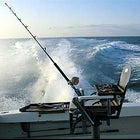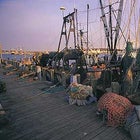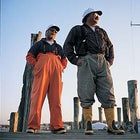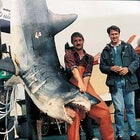I CAN’T SEE ANYTHING from the bridge of the Blue Fin IV. No land, no boats, nothing. Waves rolling from the distant edge of earth slide beneath the port side, rocking us slowly and firmly to the eerie percussion of water on wood—a rhythm broken only by the occasional stroke of a shark brushing against the hull.





Beneath me, in the boat’s cockpit, Rocko Cole is performing his primary duty as first mate: He’s laying out the chum line, a miles-long slick of fish blood, shredded fish flesh, and little bits of fish gut. For what he calls “surface effect,” Rocko has included a decorative assortment of candy wrappers, a cardboard box, cigarette butts, and an empty Starbucks Frappuccino bottle. With a fillet knife, he begins mincing a three-pound, half-dead bluefish. Every minute or so he flings a scoop of the bloody soup over his left shoulder into the ocean. Rocko’s knife-working arm has a tattoo of a dagger slicing through a heart that says “Kathy.”
Up on the bow, Captain Michael Potts is wearing a blue flannel shirt, and his tan corduroys are jacked up over his rounded belly by thick suspenders. He’s 47 and has a short, solid build, a mustache, a set of aviator shades, and a white sun visor with tufts of black hair shooting above its band. He’s releasing a small black kite into the wind while explaining why he decided to bring us to this particular spot of ocean. The answer to that riddle includes a temperature break created by an eddy of warm Gulf Stream water spinning in a band of cooler coastal water.
There are three clients on board: an intense, middle-aged New Jersey businessman with reddish hair, and his two college-aged sons. The father is talking nonstop, trying to convince his sons that fishing is exciting—I get the feeling that this trio has been on a lot of father-inspired outings—but both boys are fast asleep in the deck chairs. Son number one has the short, bleached, combed-forward hair that typifies violence-prone suburban youth; son number two is conservatively groomed in a way that suggests he’s overshadowed by his younger brother.
From the captain’s chair of the Blue Fin IV, I scan the technology at my fingertips: GPS, two marine radios with scramblers, a cell phone, a radar screen, and a chromoscope. We’re drifting at three miles per hour in a north-northwest direction over 240 feet of water, 25 miles south of Montauk Harbor, Long Island. The water temperature is 68 degrees, warming slightly. What I can’t tell from these instruments, though, is the one thing Captain Potts, Rocko, and the New Jersey businessman want to know: Is there a mako shark around here that is big enough to take the pot in Star Island Yacht Club’s Mako Mania shark-hunting tournament? To answer this question, we keep chummin’.
What we do have circling us are blue sharks. I’m surprised they hang around after learning that we’re a custom built, diesel-powered, 41-foot wooden sportfishing vessel and not a dead, bloated whale. There are four or five of them, each longer and heavier than a full-grown man, with iridescent indigo backs and long pectoral fins that make them look like underwater fighter planes. The sharks run their dorsal fins out of the water, then melt away into the depths only to return out of nowhere to chomp into the teaser, a 40-pound yellowfin tuna carcass hanging over the side of the boat on a cable. Rocko grabs the line and yanks it away from them like he’s pulling a shoe from a poodle.
Blues weigh up to 450 pounds, but they’re not what Potts is after today, and he regards them as a gardener would a weed infestation. This tournament pays out only for the much less common short-finned makos. Weighing up to a thousand pounds and traveling at speeds of 30 miles per hour, makos can actually leap out of the water, and they’re the only known predators of swordfish and marlin. Scientists have documented them attacking humans with a calculated method called “repeated bump and bite,” which doesn’t make me very keen on the idea of falling in.
But seeing one at all in these waters is rare, as years of commercial fishing, shark tournaments, and by-catch (when sharks are killed in nets or on lines set for other species) have reduced all shark populations in the North Atlantic by 50 to 80 percent since the early 1970s. Despite fewer sharks and increasingly strict recreational-fishing regulations (currently one shark per boat per day, and it must be longer than 4.5 feet), shark hunting is still a popular pursuit around Long Island. This is Star Island Yacht Club’s ninth annual two-day tournament, and there are 30 participating boats, none of which is anywhere in sight.
So we chum and wait. Potts decides not to set any hooks until the blue sharks clear out. He doesn’t want to sacrifice his tackle and live bait to the blues, which doesn’t please the New Jersey businessman. He chartered this boat for the tournament, and he wants some goddamn hooks in the water. His two sons, now awake, giggle nervously, trying to gauge the seriousness of this dispute between their old man and the captain.
I pass the time grappling with a fisherman’s identity crisis I’ve been having out here on the water. One minute I imagine us a group of friendly outdoorsmen, honoring our primordial desire to fish while we contribute to the local economy. The next minute, I think, we’re nothing but machismo afloat, looking to kill another member of an already depleted species for a cash prize and local notoriety while littering the ocean and burning up volumes of diesel fuel.
Be patient, Potts says. Rocko ladles out another scoop of chum and lights up a smoke.
SITTING OUT ON THE eastern tip of Long Island, Montauk has the vibe of an isolated American outpost—a hard-core fishing town holding off the encroachment of the land-hungry, moneyed culture of the Hamptons, just to the west across an isthmus. While the Hamptonians sleep off gin fizzes and lobster bisque, the streets of Montauk are wide-awake before daylight. Beat-up pickups hauling bait, fuel cans, and dismantled outboard motors putter along like rolling hangovers. The most common bumper sticker in the area depicts a lighthouse next to a shark’s head that is gobbling up the words fish montauk.
At one time, the waters off Montauk offered abundant big-game fishing. Not anymore. The past decades of poorly regulated commercial harvesting have nearly wiped out the swordfish, marlin, and tuna populations that gave the town its “Sportfishing Capital of the World” moniker. Now, if you want big-game fishing action here, sharks are the only reliable choice.
Montauk’s modern shark-hunting era began on June 6, 1964, when local fisherman Frank Mundus harpooned a 4,500-pound great white that was feeding on a drifting whale carcass just off the coast. Mundus began marketing himself as the “Montauk Monster Man,” promoted “Monster Fishing” to charter clients, wore a nasty-looking shark tooth around his neck, and made a spectacle of hauling out huge sharks and then hacking them to pieces on the harbor docks. Novelist Peter Benchley molded Mundus’s methods into the Quint character in his 1974 novel Jaws. The Spielberg movie followed in 1975, and it not only scared beachgoers out of the water, but prompted marinas up and down the Atlantic seaboard to start hosting shark-hunting tournaments. Many of those tournaments have since disappeared, but Montauk’s contests are still well attended, and this week hundreds of tourists and participants are converging at the Star Island Yacht Club, a large, full-service marina in Montauk Harbor.
Star Island hosts two of the town’s four major annual shark-hunting tournaments: the Star Island Shark Tournament, in June, which offers awards for heaviest shark, heaviest mako, heaviest blue shark, and heaviest “other” shark; and Mako Mania, in August. Mako Mania is the connoisseur’s event—the mako-only policy decreases the chances that an unskilled fisherman is going to have a shark to enter at the end of the day. Some conservationists applaud the tournament’s restrictive policy; Star Island also invites marine biologists to the awards ceremony to examine any captured sharks. And makos, unlike other sharks, taste like swordfish, and get eaten.
Captain Michael Potts keeps his boat on the other side of the harbor from Star Island Yacht Club, at the far less swanky charter docks. His slip has a wooden archway decorated with several sets of shark jaws. The Blue Fin IV, as I see when Potts pulls in a few mornings before the tournament with a load of charter clients, is immaculate and without decorative frill, like something the U.S. Navy would design if it were into fighting fish.
The cabin looks like a fishing-supply warehouse. “Fishing has gotten so complicated,” Potts says, pointing out all the equipment. “Those are gaff heads, that’s ultralight tackle, light tackle, medium tackle, and heavy, offshore equipment. About 40 rods, conservatively. That’s the freezer, where we keep bait, which reminds me that I’ve got to stop off and place an order. Those are kites, lure boxes, wire leaders, flying gaffs, cockpit stick. That’s the head in there. That’s my shotgun—Mossberg 12-gauge, pump action, stainless barrel. We use it on big sharks that are otherwise hard to get in the boat. Life ring, survival suits.
“But it hasn’t always been like this,” he continues. “I used to bring girlfriends down here to fool around. There were even cushions to lie on. Fishing’s gotten so complicated now.”
Potts has been fishing Montauk since he was eight. He would ride shotgun in a two-seater airplane with his mother, Margaret, searching the Atlantic for basking swordfish. When they found one, they’d drop a note in a bottle with the fish’s coordinates to his father, George, in his boat below, and he would attempt to head the fish off and harpoon it. The summer after graduating from East Hampton High School in 1973, Michael began captaining the Blue Fin IV. After a brief exile to the Florida Institute of Technology, where he earned a bachelor’s degree in environmental biology, Potts returned to Montauk in 1981; he took over the family business three years later and now does charter fishing almost exclusively.
Potts never participates in a shark tournament for his own enjoyment; if he joins one, it’s because he’s been hired by a paying client. Potts gets $1,000 for a day of chartered big-game fishing, and the New Jersey businessman who hired Potts for this year’s event paid the boat’s $600 tournament registration fee. Star Island pays out $4,000 for the biggest mako, on down to $1,000 for the fourth-largest, but the real money in Mako Mania comes from side-betting pools called calcuttas, which cost from $200 to $2,000 to buy into. The payout is up to several hundred thousand dollars. Potts and the New Jersey businessman entered three calcuttas and agreed to split whatever they might win.
Of the 30 Montauk shark tournaments Potts has fished, he’s helped his clients to catch prizewinning sharks in six of them, the biggest a 724-pound tiger shark. The client’s only responsibilities are to show up at 5 a.m. and then take a seat. It’s a shark safari, with Potts guiding his client to a fish, setting up the bait, and then handing off the rod.
THE DAY BEFORE THE tournament, I was up before dawn to go catch-and-release shark fishing with Carl Safina, a lifelong fisherman and the founder and director of the Audubon Society’s Living Oceans Program, based in nearby Islip, Long Island. Safina and his staff of eight scientists and lobbyists use environmental and fishing-policy analysis to convince nations around the world to protect fish and their habitats. In 1997, a coalition led by Living Oceans successfully lobbied the National Marine Fisheries Service to have the Atlantic Coast’s commercial shark-kill quota cut in half. Safina’s 1998 book Song for the Blue Ocean is a poignant chronicle of the world’s declining fisheries and those who rely on them.
Safina, 46, is of medium height with a dark beard and wavy brown hair, topped by a Living Oceans cap. We were going out on the Miss Peach, a 30-foot Black Watch sportfishing boat owned and piloted by his friend Timothy Dykman, a local artist and fisherman, to hunt down a few of the North Atlantic’s sharks and check them out firsthand. We motored 18 miles south to a place called the Butterfish Hole, and Dykman cut the engine and lowered a perforated bucket of ground fish into the water. Safina filleted a bluefish and laced a hook—its barb filed off so it could be pulled out of the fish’s mouth easier—through the meat. He slowly let out the line behind the boat until it was 60 yards back. A hunk of foam rubber kept the bait floating just below the surface.
Safina said he doubted we’d find a mako; now mostly blue sharks prowled here. “People used to fish these waters for giant tuna and swordfish, and they’d get besieged by sharks, sometimes as many as a hundred a day,” he said. “No one wanted them; they were considered trash fish.” But by the late 1980s, swordfish and the great schools of tuna were almost gone. “If you wanted to consistently catch big fish—and tourists do—sharks were it. They were the only thing left that was easily available.”
Soon the commercial fishing industry realized that a lot of money could be had from sharks—or shark fins, to be specific, which are sold to Asian markets for shark-fin soup. The other 95 percent of the animal, of such little value that it’s not worth refrigerating, gets dumped overboard and sinks to the bottom where it dies from blood loss. (In 1998, President Bill Clinton approved a law banning the practice of finning in U.S. waters, but there are still no regulations for international waters, 200 miles beyond U.S. shores.)
Suddenly Safina jumped up, grabbed the rod, and started reeling like a madman. He handed the rod to me and I shoved the butt of it into my belly and held on tight. The strain on my arms from the running blue shark felt like I was doing a chin-up. It was the first time in my life I’ve been hooked into a creature that weighed more than me.
At first that fish and I just had fun with each other, testing our skills and stamina. He’d come my way some, I’d go his way some, but I knew this would lead somewhere else, like a little playful wrestling that could at any moment turn into dirty sex. Things between us slowly became serious, angry, and mean. I thought that fucker was going to tear my arms off, and then I didn’t care if he did. I poured myself into that 150-pound-test line, and the shark did, too, all couple-hundred pounds of him. Again and again he fled from me to the depths, and every time I hauled him back up. We might have stayed there forever, locked in a monofilament embrace, but eventually Safina jumped in when the shark was near the boat and popped the hook free, divorcing us.
“Some sharks take ten years to reach sexual maturity,” Safina said as I massaged my arms. “If everyone decided right now to just leave them alone, it would be years until you noticed any improvement. And even then it would happen very slowly.”
Another blue shark had followed the chum to the boat. He looked to be the size of a pro wrestler. He stayed close, pacing the boat like a heeling dog.
“Far be it from me to understand why people join those tournaments,” Safina said. “The marinas who put them on do it because they can make a lot of money from entrance fees and retail and service sales. It’s a business. But I don’t want you to think that shark tournaments, or even recreational shark fishing, are wholly to blame for declined shark populations. Finning and by-catch are the main factors. In the grand scheme, shark tournaments are almost beside the point. My aversion to them comes from attaching a carnival atmosphere to the killing of a big, beautiful fish—something that, if done, should be deeply contemplative and personal.”
Safina was still caught up in the grace and allure of landing a fish. He respected Potts and told me that I was lucky to be going out with him, that Potts was a good fisherman. But Potts didn’t plan on throwing his makos back.
THAT IS, IF HE could find any. No makos turned up on the first day of the tournament. Now it’s day two, three hours in: Potts, Rocko, the New Jersey trio, and I are drifting along at the head of a chum line when we hear on the tournament’s official radio station that someone boated a mako of over 300 pounds, the fish to beat.
Potts has his black kite out again. He flies it out with a small clip halfway up the string, and he attaches a fishing line to the clip. One end of the line is spooled onto a rod and reel on the boat, and the other end hangs down from the kite string to the water’s surface, where it is tied to two big hooks lashed to a live three-pound bluefish. The kite keeps the fish bobbing at the surface, but it’s not strong enough to pull the fish out of the water. The technologies that bring us e-mail and intercontinental ballistic missiles are completely unimpressive to me, but the ingenuity of this kite idea blows my mind.
Just as I’m getting ready to doze off on the bridge, son number two starts yelling, “The kite, the kite, the kite!” I look over and something the size of a canoe is thrashing at the live bait, which is bucking against the kite and bopping in and out of the water. After what seems like a full minute, the shark gets hold of the bait, starts to pull the kite down into the water—and then loses the bait. The little bait fish comes popping back up and the shark nails it again, hooks and all. This time the shark pulls hard enough to pop the line free from the clip on the kite string, releasing the kite and connecting itself directly to the rod and reel via a length of 100-pound-test monofilament.
Potts says it’s a very large blue shark. The clients decide to fight the fish for fun, and the battle lasts about 45 minutes as they take turns with the rod. All the while, the two who aren’t holding the rod joshingly punch the one who is and say things like, “Come on, you pussy, get that fucking guppy in here!” When they get the shark to the boat, it shows its disdain for the whole procedure by biting and thrashing at the hull, biting at the wire leader, and biting at Potts, who is trying to cut the leader while yelling at the clients to get out of the way.
The blue shark has another stainless-steel hook in its jaw besides the two we’re going to leave it with. This is the least of its worries, though, as it is also tangled in a piece of discarded fishing net, which has cut an inch-deep gash all the way around the fish’s head and across its gill openings. As it bucks and thrashes, I ask Rocko if he’s going to cut the net off. He looks at the fish’s open, tooth-riddled mouth and says, “If you want to get down there and take that net off, be my guest.” I decline. Potts cuts the wire and the fish wags itself straight down. The blue and white sheen of its skin fades to ocean green and then disappears like really good magic.
And so we wait again. Rocko chops and ladles. Potts passes the time by telling his version of a story that is well known around Montauk, about a controversial occurrence that happened at a 1987 shark tournament weigh-in. He and his clients came in with a tiger shark that was a definite contender for the biggest catch, and against the usual protocol Potts hung it head-up on the scale. Another angler with a near-winner complained about this position. When they weighed the fish hanging by the tail, Potts says, “Two small sharks, a tuna, and a pound of packaged ground beef fell out of the fish’s mouth.”
Which raises an obvious question.
“No, I wouldn’t do that,” Potts says, grinning. “Why risk getting caught stuffing a shark for one single pound?”
“But the two sharks and the tuna weighed way more than a pound,” I point out. “Why’d you hang it by the head?”
“We already had a hook in its head, so it just went up like that.”
“Come on, man, packaged ground beef?”
He just shrugs and says that tiger sharks are scavengers, and then points to all the stuff we threw into our chum line, suggesting, I suppose, that the shark could have gotten the plastic-wrapped hamburger anywhere. Either way, Potts and his clients took first place. Case closed.
“BIG FUCKIN’ MAKO, big fuckin’ mako!”
Rocko’s yelling and I jump up to see what’s happening. A mako, he says, just came up to the teaser, checked it out, and swam off. He figures it was a definite big-money contender. Just then a blue shark cruises past, but Rocko gives it a thorough bitching out and it leaves. Potts is super tuned-in now, and a small trace of excitement has, for the first time in two days, come across his face.
The mako takes the bait.
Potts reefs on the rod three times, reeling hard, and he’s banjo-tight on the fish, which seems to be hell-bent on a trip to England. Heading east, the fish sounds and the reel lets out a long painful scream. The fish rises back up to the surface, heads southwest, and then sounds again in a deep run. Potts and Rocko go ballistic.
“Cut that leader off on the kite rig, just let the whole thing go!” Potts yells at Rocko. “On the dash are two black keys,” he screams at me. “Turn both those black keys to the right. Now hit the green button.”
The boat kicks into motion and begins a curve that will circle the running fish to keep it on the port side.
The kite rig is cut free so it can’t tangle the line, and Rocko throws all the other gear up in the cabin to clear room for the shark. He readies the gaffs, tying them off to the base of the fighting chair in case they need to fight the fish with ropes after they get a gaff into its side. The father takes the rod, and Potts and Rocko try to strap him into a rod-holding harness. The father says he doesn’t need the harness and Potts snaps at him to wear it anyway. Potts has told me stories about men being strapped to a rod that was hooked into a giant fish and getting pulled over the side of the boat, never to surface again. The reel screams some more.
One minute the shark is somewhere way below us off the stern, tearing out line. Then the line goes slack. Potts grabs the rod from the father and reels frantically, but the hook’s pulled free.
No one says a word. For the first time all day Potts just stands there, doing nothing. The sons put their camcorder back in its box and recline in their chairs. The dad takes off the fighting harness. So much for mako mania.
WITH A SHARK hanging by its tail, you can show its teeth by grabbing its nose and lifting up like you’re bending the neck back. I learn this trick by watching the photo shoot taking place at Star Island Yacht Club’s awards ceremony. The anglers pose next to a 364-pound shark’s head, making growling faces to show their own teeth. One of the fishermen says, “Be careful, they’ll bite you hours after they’re good and dead.”
With no whopper shark to weigh, the Blue Fin IV gang decided to skip this circus. There’s a crowd of several hundred people, including TV journalists and newspaper reporters. Families of tourists mill around. The women and children are completely unabashed about their amazement at the toothy sharks. The men stare at the fish with practiced nonchalance, like they would have caught a bigger one had they tried.
Of the 30 registered boats, only five caught makos, and the 364-pound beast takes first prize. It was caught by a group of cigar-smoking Long Islanders, led by a local captain. Once the sharks are down from the hanging hooks, scientists from the University of Connecticut start picking at them. One, a zoologist named Gaines Tyler, is a young, clean-cut guy in a baseball cap. He works with the National Marine Fisheries Service, and he’s looking for parasites on the sharks. One parasite, Clistobothrium montaukensis, was discovered for the first time in a shark caught here at a tournament, Gaines tells me. It’s not known yet whether the parasites have any greater scientific significance; for now, Gaines is just trying to catalog new types.
Things slowly wind down on the docks, and the zoologists pack up their equipment and their parasites. The calcuttas have been handed out, the news people got their stories, the charter captains got paid, the spectators got their fill of gore and Instamatic photos. Everyone has migrated up toward Star Island’s bar, which is jumping. Live music will be kicking in soon. When the last mako is dragged off, it leaves a trail of blood leading down the dock to a large white cooler. A little girl in a pink T-shirt and baby-blue sandals is making a game of skipping from one splotch to another, smiling on down the chum line.


